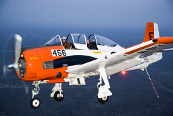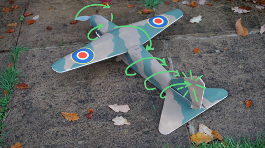
T-28 Surprise!
Far as I know, no one ever spilled the beans.
We’re in a growling bouncing climbout from Navy Whiting Field north of Pensacola, Florida. We left the cloud deck behind back at 5000 feet and now as briefed, we’re leveling off at 11,000 ft. I push the nose over and accelerate from the 120 kt climb to 180 kt cruise and pull the 1425 horses back and retrim the rudder for cruise.
It’s my first flight in the powerful orange and white North American T-28 Trojan. Prior to today, after Primary Training I had a whopping thirty hours in thirty days in my logbook in the agile, well-mannered T-34 Mentor, of Bonanza heritage, 245 hp I believe. You’d think transitioning to the T-28 would be pretty straight-forward, after all, it’s just another trainer. But not so. The T-28 will kill you real quick.
The T-28 is a complex aircraft with a monster motor, and 14 feet tall at the tail. Any adjustment triggers several more. Truly a handful. The military had learned, at a high price, that they needed to get your attention big time and impress upon you what this beast will do if you get behind or don’t treat it with respect, especially on go-arounds. So they have a big surprise in store for those moving up into this league. Today is my turn in the barrel.
At today’s preflight briefing the instructor mentions that you will be doing most of the flying. You are again admonished on takeoff not to exceed 36 inches manifold pressure until 60 kts indicated, then you can advance to 48 inches MP. He will be guarding the throttle to ensure that. After takeoff you are going to climb up to 11,000 feet, complete an overhead break pattern, and make a simulated landing at 10,000 feet. He emphasizes the importance of setting rudder trim at 5 degrees right rudder for takeoff, and re-trimming the rudder to zero at cruise. You are very familiar with the overhead break pattern because every day you and your buddies from the vultures row porch watch dozens of students flailing through it.

The standard overhead break and landing pattern goes something like this:
From the IP (Initial Point) you come roaring toward the airfield at 180 knots for a left break to downwind. You heroically bank and pull into a 35 to 45 degree turn, reduce power and trim, extend the speed brake, trim, extend the gear and flaps, trim, and add power for 120 knots, trim, level the wings on downwind, trim, all while deftly keeping the altimeter frozen at the target altitude. It’s a challenge. Without proper attention, just flicking the thumb button extending the speed break on the belly is good for a 300 foot altitude excursion. And don’t forget to adjust the cowl flaps for the changing power settings and speeds, you want to keep those nine five-gallon-bucket sized cylinders happy.
During these changes in power, propwash, torque, configuration, heading and speed, the instructor allows you a fifty-foot altitude deviation, about half an inch leeway on either side of the altimeter mark.
Then, rumbling downwind, dirty and trimmed at 120 knots you call the base turn, reduce power to seventeen inches and muscle in 30 degrees bank and hold 110 knots around the constant banked Navy style circular base leg, adjusting to hit the 90 degree position on-altitude and ideally rolling final wings level on final at about 400 feet, and slowing through 90 knots you reduce power, flare, and adroitly touch down. You have landed successfully. Nothing to it.
On final, normally, the student pilot has been descending and slowing, reducing power, and has not though about rudder trim for some time, which is fine, unless the approach path is off and you need to go around (Missed Approach) which includes adding full power. When you throttle up all the way at that low speed, the huge radial engine and the surfboard-sized prop blades surge and 1425 hp of ferocious helical propwash circles around the fuselage and pushes the vertical tail to the right. If you didn’t retrim and don’t have the TAKEOFF 5 degrees right trim applied even full right rudder isn’t enough. The large nose pivots left and the engine blocks the airflow off the left wing, the wing drops and presto you have an inverted spin! At 400 feet! Evidently that had happened with students on their first solo, so they added this first-flight surprise, with an instructor.
So when training, the unwary student adds power at 10,000 ft, he’s about a mile behind the aircraft, and everything goes upside down and dirt and pencils and paperclips and washers are floating around. For safety when the wings reach 90 degrees bank the instructor preemptively takes the controls and flies the plane home and you have a little talk. That’s how the training flight normally goes, thankfully all at 10,000 feet, two miles above the ground.

So back to my first T-28 flight –
There I was – on final glidepath at 10,400 feet, on-speed and on-heading. All was well with the world, looking good. The instructor says “OK. Good work, let’s go!”
While i was looking around clearing left and right for traffic, I noticed the instructor in the back take a good grip on the grab handles and cock his neck to the side and settle into the seat a little like a baseball batter settling in at the plate. What’s that all about?
Seeing the instructor getting ready for something physical, I advanced the throttle a little more cautiously. Whoa! The nose pivoted and the left wing started to drop. Still cautious I held off on more throttle for a second and pushed the nose over and got enough right stick and rudder in to hold the roll at about seventy degrees bank. I nosed-over for airspeed and worked the throttle in and manhandled it back to level. Later, rethinking through the event, it occurred to me that, like every other first-timer, i had forgotten the rudder trim was still trimmed at zero for 180 kt cruise! I had been fortunate to recover. From what the instructor muttered I could tell he wasn’t happy that he didn’t get to take over the aircraft.
Things settled down and he asked, “What’s your altitude?”
I said, “7000 feet”.
A 3000 foot loss.
He asked, “OK, we started at 10,400 ft. For training purposes, what was your simulated altitude back there?”
I said, “400 feet.”
Lesson learned.
We climbed to 11,000 and did another approach. This time the go-around included re-trimming the rudder and applying power and rudder deliberately, keeping the heading and altitude on target.
Flying today, now, you put two and two together. That day you learned that the cautions for takeoff also apply on a wave-off, or go-around. Now you have the working image that on takeoff, if the full 48 inches MAP is put in all at once, you are just along for the ride, and make a quick left turn off the runway and become a very powerful and loud orange and white weed eater.
Propwash makes lots of things fun. On a loop it can turn you at the top so that somehow you come out 90 degrees off heading, or worse.
Something most don’t think about, because of propwash, some mighty WWII era prop airplanes and others have the vertical tails offset, canted at an angle for a cruise trim setting such that with zero degrees trim the rudder is faired with the canted vertical stabilizer, to offset the cruise power propwash pushing on the vertical tail. On 2000 hp aircraft the angle is pronounced.
To that point, years ago I heard a builder mention that his kit was defective, that it had been delivered with the vertical tail screwed up – misaligned, but that he had cut it off and reinstalled it straight…
****
Walking in from your first Trojan flight, several instructors walk out and meet your instructor. They ignore you and murmur for a moment and then guffaw and slap each other on the back.
Your ‘in-the-know’ buddies crowd out onto the vulture’s row porch. They lean forward over the rails, grinning big and about to bust, waiting to hear if your harrowing tale can match theirs. And until you‘ve had your turn, nobody spills the beans.
Today you learned. But tonight you don’t sleep. Tonight you internalize. The lesson of the day becomes yours. From now on, when you need it, You see it, It’s your original idea. Many other long days and short nights build your aviation experience. You become.
One day in the de-brief room your instructor tells another instructor that you have everything in one bag. So the other students can know that it is possible to succeed, he says it loud enough for the other student pilots hear. And over the weeks and months your walk to the plane is a little stronger, a little surer. Not bravado anymore, but confident assurance of the power and the limits. That’s what you do.
And keeping tradition you don’t spill the beans to your buddies either.
Good flying-
Bill James, Fort Worth VariEze
There was supposed to be Anhedral?
ATP
SFTE Member Society of Flight Test Engineers

Two Favorites
From 2015 Oshkosh Promo Video, VariEze N95BJ and T-28, with 135 other aircraft following for takeoff.
Approximations:
VEze -2 seats and 180 kts. T-28 -2 seats and 180 kts.
VEze 700 lbs. T-28 7000 lbs
VEze 4 gph. T-28 40 gph, and 4 qts per hour :)and

I was in the multi-engine pipeline so all I got was to fly radio instrument training in the T-28 in the back seat not getting to take off and land to which I as a lowly cadet complained to my Marine Major instructor. To my surprise, one day he pulled out on the runway, lined it up, told me to go under the hood, and said “you got it.” Not bragging but he said that I made a perfect takeoff. I don’t believe the takeoff was nearly as challenging as a visual takeoff in the SNJ. As an average high school baseball player and poor country boy doing many similar tasks, I had excellent hand and eye coordination. I got pretty much above average on every category on every flight in the ’28.